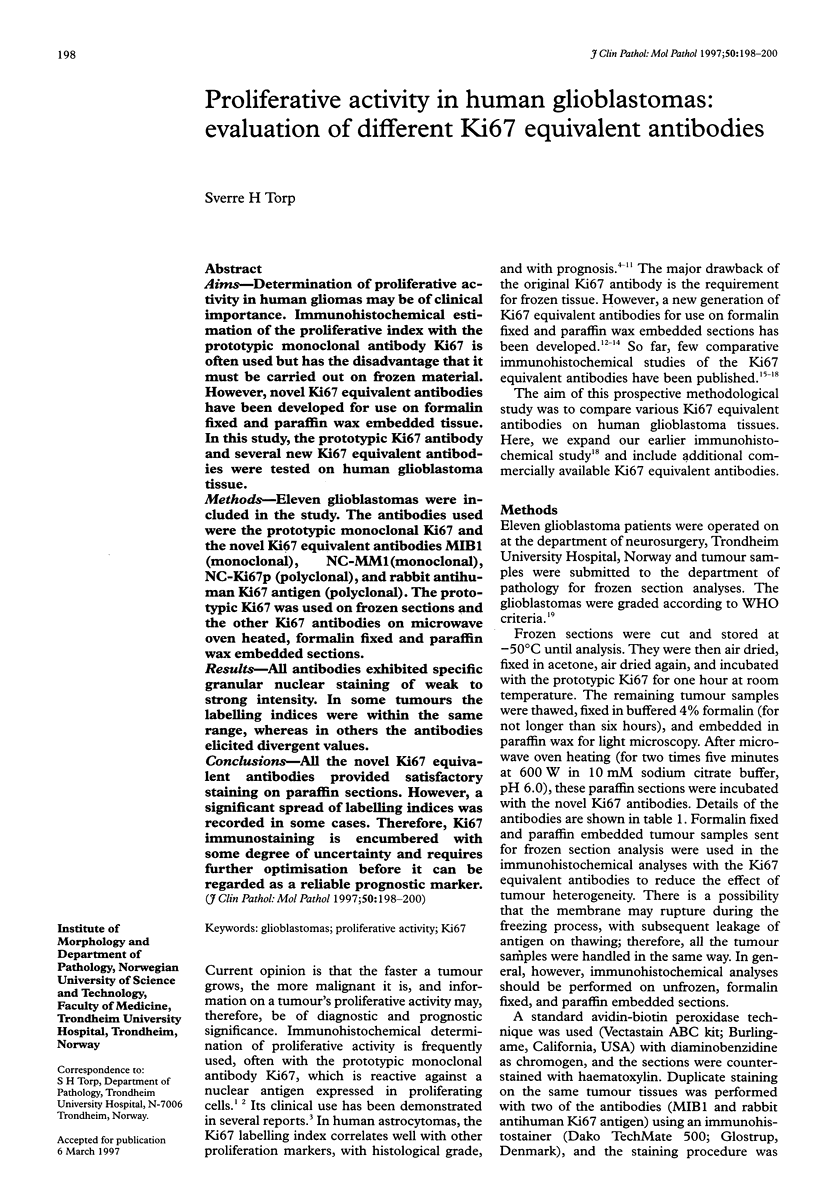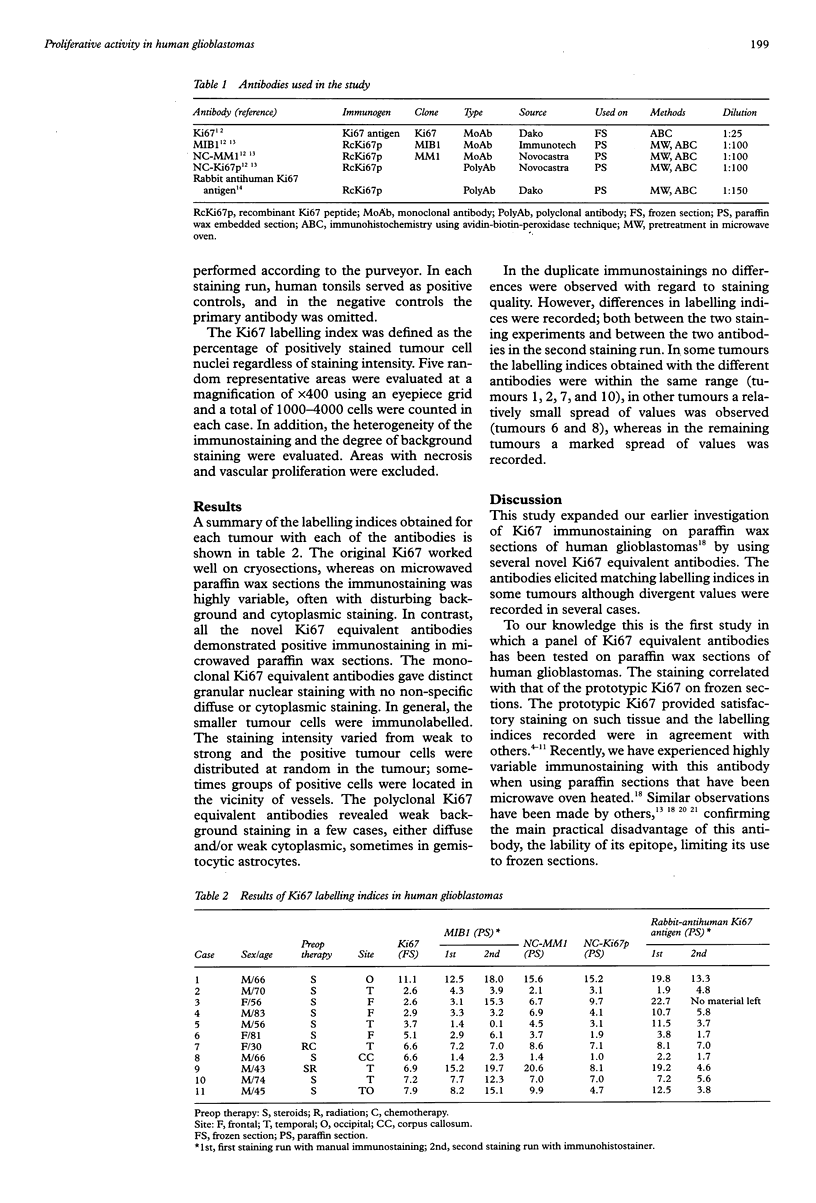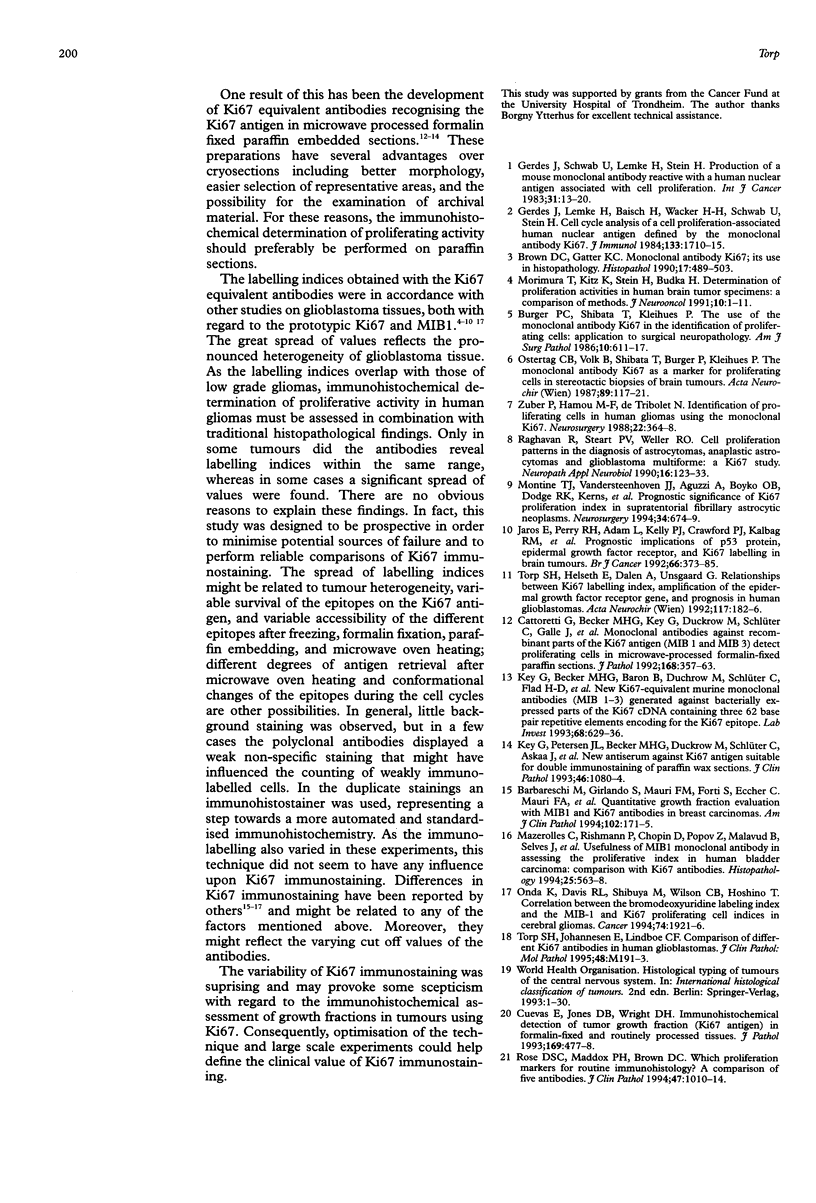Abstract
AIMS: Determination of proliferative activity in human gliomas may be of clinical importance. Immunohistochemical estimation of the proliferative index with the prototypic monoclonal antibody Ki67 is often used but has the disadvantage that it must be carried out on frozen material. However, novel Ki67 equivalent antibodies have been developed for use on formalin fixed and paraffin wax embedded tissue. In this study, the prototypic Ki67 antibody and several new Ki67 equivalent antibodies were tested on human glioblastoma tissue. METHODS: Eleven glioblastomas were included in the study. The antibodies used were the prototypic monoclonal Ki67 and the novel Ki67 equivalent antibodies MIB1 (monoclonal), NC-MM1 (monoclonal), NC-Ki67p (polyclonal), and rabbit antihuman Ki67 antigen (polyclonal). The prototypic Ki67 was used on frozen sections and the other Ki67 antibodies on microwave oven heated, formalin fixed and paraffin wax embedded sections. RESULTS: All antibodies exhibited specific granular nuclear staining of weak to strong intensity. In some tumours the labelling indices were within the same range, whereas in others the antibodies elicited divergent values. CONCLUSIONS: All the novel Ki67 equivalent antibodies provided satisfactory staining on paraffin sections. However, a significant spread of labelling indices was recorded in some cases. Therefore, Ki67 immunostaining is encumbered with some degree of uncertainty and requires further optimisation before it can be regarded as a reliable prognostic marker.
Full text
PDF


Selected References
These references are in PubMed. This may not be the complete list of references from this article.
- Barbareschi M., Girlando S., Mauri F. M., Forti S., Eccher C., Mauri F. A., Togni R., Dalla Palma P., Doglioni C. Quantitative growth fraction evaluation with MIB1 and Ki67 antibodies in breast carcinomas. Am J Clin Pathol. 1994 Aug;102(2):171–175. doi: 10.1093/ajcp/102.2.171. [DOI] [PubMed] [Google Scholar]
- Brown D. C., Gatter K. C. Monoclonal antibody Ki-67: its use in histopathology. Histopathology. 1990 Dec;17(6):489–503. doi: 10.1111/j.1365-2559.1990.tb00788.x. [DOI] [PubMed] [Google Scholar]
- Burger P. C., Shibata T., Kleihues P. The use of the monoclonal antibody Ki-67 in the identification of proliferating cells: application to surgical neuropathology. Am J Surg Pathol. 1986 Sep;10(9):611–617. doi: 10.1097/00000478-198609000-00003. [DOI] [PubMed] [Google Scholar]
- Cattoretti G., Becker M. H., Key G., Duchrow M., Schlüter C., Galle J., Gerdes J. Monoclonal antibodies against recombinant parts of the Ki-67 antigen (MIB 1 and MIB 3) detect proliferating cells in microwave-processed formalin-fixed paraffin sections. J Pathol. 1992 Dec;168(4):357–363. doi: 10.1002/path.1711680404. [DOI] [PubMed] [Google Scholar]
- Cuevas E., Jones D. B., Wright D. H. Immunohistochemical detection of tumour growth fraction (Ki-67 antigen) in formalin-fixed and routinely processed tissues. J Pathol. 1993 Apr;169(4):477–478. doi: 10.1002/path.1711690415. [DOI] [PubMed] [Google Scholar]
- Gerdes J., Lemke H., Baisch H., Wacker H. H., Schwab U., Stein H. Cell cycle analysis of a cell proliferation-associated human nuclear antigen defined by the monoclonal antibody Ki-67. J Immunol. 1984 Oct;133(4):1710–1715. [PubMed] [Google Scholar]
- Gerdes J., Schwab U., Lemke H., Stein H. Production of a mouse monoclonal antibody reactive with a human nuclear antigen associated with cell proliferation. Int J Cancer. 1983 Jan 15;31(1):13–20. doi: 10.1002/ijc.2910310104. [DOI] [PubMed] [Google Scholar]
- Jaros E., Perry R. H., Adam L., Kelly P. J., Crawford P. J., Kalbag R. M., Mendelow A. D., Sengupta R. P., Pearson A. D. Prognostic implications of p53 protein, epidermal growth factor receptor, and Ki-67 labelling in brain tumours. Br J Cancer. 1992 Aug;66(2):373–385. doi: 10.1038/bjc.1992.273. [DOI] [PMC free article] [PubMed] [Google Scholar]
- Key G., Becker M. H., Baron B., Duchrow M., Schlüter C., Flad H. D., Gerdes J. New Ki-67-equivalent murine monoclonal antibodies (MIB 1-3) generated against bacterially expressed parts of the Ki-67 cDNA containing three 62 base pair repetitive elements encoding for the Ki-67 epitope. Lab Invest. 1993 Jun;68(6):629–636. [PubMed] [Google Scholar]
- Key G., Petersen J. L., Becker M. H., Duchrow M., Schlüter C., Askaa J., Gerdes J. New antiserum against Ki-67 antigen suitable for double immunostaining of paraffin wax sections. J Clin Pathol. 1993 Dec;46(12):1080–1084. doi: 10.1136/jcp.46.12.1080. [DOI] [PMC free article] [PubMed] [Google Scholar]
- Mazerolles C., Rishmann P., Chopin D., Popov Z., Malavaud B., Selves J., Neulat-Duga I., Bellot J., Delsol G. Usefulness of MIB1 monoclonal antibody in assessing the proliferative index in human bladder carcinoma: comparison with Ki-67 antibody. Histopathology. 1994 Dec;25(6):563–568. doi: 10.1111/j.1365-2559.1994.tb01375.x. [DOI] [PubMed] [Google Scholar]
- Montine T. J., Vandersteenhoven J. J., Aguzzi A., Boyko O. B., Dodge R. K., Kerns B. J., Burger P. C. Prognostic significance of Ki-67 proliferation index in supratentorial fibrillary astrocytic neoplasms. Neurosurgery. 1994 Apr;34(4):674–679. doi: 10.1227/00006123-199404000-00016. [DOI] [PubMed] [Google Scholar]
- Morimura T., Kitz K., Stein H., Budka H. Determination of proliferative activities in human brain tumor specimens: a comparison of three methods. J Neurooncol. 1991 Feb;10(1):1–11. doi: 10.1007/BF00151242. [DOI] [PubMed] [Google Scholar]
- Onda K., Davis R. L., Shibuya M., Wilson C. B., Hoshino T. Correlation between the bromodeoxyuridine labeling index and the MIB-1 and Ki-67 proliferating cell indices in cerebral gliomas. Cancer. 1994 Oct 1;74(7):1921–1926. doi: 10.1002/1097-0142(19941001)74:7<1921::aid-cncr2820740716>3.0.co;2-9. [DOI] [PubMed] [Google Scholar]
- Ostertag C. B., Volk B., Shibata T., Burger P., Kleihues P. The monoclonal antibody Ki-67 as a marker for proliferating cells in stereotactic biopsies of brain tumours. Acta Neurochir (Wien) 1987;89(3-4):117–121. doi: 10.1007/BF01560376. [DOI] [PubMed] [Google Scholar]
- Raghavan R., Steart P. V., Weller R. O. Cell proliferation patterns in the diagnosis of astrocytomas, anaplastic astrocytomas and glioblastoma multiforme: a Ki-67 study. Neuropathol Appl Neurobiol. 1990 Apr;16(2):123–133. doi: 10.1111/j.1365-2990.1990.tb00941.x. [DOI] [PubMed] [Google Scholar]
- Rose D. S., Maddox P. H., Brown D. C. Which proliferation markers for routine immunohistology? A comparison of five antibodies. J Clin Pathol. 1994 Nov;47(11):1010–1014. doi: 10.1136/jcp.47.11.1010. [DOI] [PMC free article] [PubMed] [Google Scholar]
- Torp S. H., Helseth E., Dalen A., Unsgaard G. Relationships between Ki-67 labelling index, amplification of the epidermal growth factor receptor gene, and prognosis in human glioblastomas. Acta Neurochir (Wien) 1992;117(3-4):182–186. doi: 10.1007/BF01400618. [DOI] [PubMed] [Google Scholar]
- Torp S. H., Johannesen E., Lindboe C. F. Comparison of different Ki67 antibodies in human glioblastomas. Clin Mol Pathol. 1995 Aug;48(4):M191–M193. doi: 10.1136/mp.48.4.m191. [DOI] [PMC free article] [PubMed] [Google Scholar]
- Zuber P., Hamou M. F., de Tribolet N. Identification of proliferating cells in human gliomas using the monoclonal antibody Ki-67. Neurosurgery. 1988 Feb;22(2):364–368. doi: 10.1227/00006123-198802000-00015. [DOI] [PubMed] [Google Scholar]


